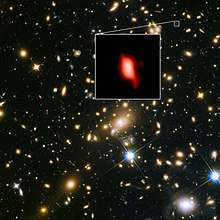MACS1149-JD1
MACS1149-JD1 (also known as PCB2012 3020) is one of the farthest known galaxies from Earth and is at a redshift of about z=9.11,[1] or about 13.28 billion ly (4.07 billion pc) light-travel distance.[4] It is one percent of the Milky Way's mass.
| MACS1149-JD1 | |
|---|---|
 Hubble and ALMA image of galaxy cluster MACS J1149.5+2223 with an inset of MACS1149-JD1 | |
| Observation data (J2000 epoch) | |
| Constellation | Leo |
| Right ascension | 11h 49m 33.584s |
| Declination | +22° 24′ 45.78″ |
| Redshift | 9.1096±0.0006[1] |
| Helio radial velocity | 2878008±59958 km/s[2] |
| Distance | 30.37 Gly (9.311 Gpc)[3] (co-moving) 13.28 Gly (4.07 Gpc)[4] (light travel) |
| Group or cluster | MACS J1149.5+2223 |
| Apparent magnitude (V) | 26.8[3] |
| Characteristics | |
| Type | Dwarf |
| Mass | 1.1+0.5 −0.2×109 [1] M☉ |
| Other designations | |
| [PCB2012] 3020, [KOI2016] HFF4C-YJ1, [ZZI2017] 663[5] | |
References
- Hashimoto, Takuya; et al. (May 2018). "The onset of star formation 250 million years after the Big Bang". Nature. 557 (7705): 392–395. arXiv:1805.05966. Bibcode:2018Natur.557..392H. doi:10.1038/s41586-018-0117-z. PMID 29769675.
- Zheng, Wei; et al. (September 2012). "A magnified young galaxy from about 500 million years after the Big Bang". Nature. 489 (7416): 406–408. arXiv:1204.2305. Bibcode:2012Natur.489..406Z. doi:10.1038/nature11446. PMID 22996554.
- "Index for [PCB2012] 3020". NASA/IPAC Extragalactic Database. Retrieved 19 May 2018.
- Lira, Nicolás; et al. (15 May 2018). "ALMA Finds Most-Distant Oxygen in the Universe" (Press release). ALMA Observatory. Retrieved 6 September 2018.
- "[ZZI2017] 663". SIMBAD. Centre de données astronomiques de Strasbourg. Retrieved 19 May 2018.
External links

- NASA Telescopes Spy Ultra-Distant Galaxy
This article is issued from Wikipedia. The text is licensed under Creative Commons - Attribution - Sharealike. Additional terms may apply for the media files.